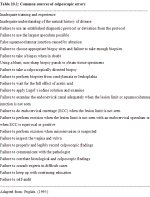Home / Training / Manuals / Colposcopy and treatment of cervical intraepithelial neoplasia: a beginnersí manual / Chapter 10: Avoiding errors in the colposcopic assessment of the cervix and colposcopic provisional diagnosis
 table 10.1: Common sources of colp...
table 10.1: Common sources of colp...
 table 10.2: A summary of colposcop...
table 10.2: A summary of colposcop...
Colposcopy and treatment of cervical intraepithelial neoplasia: a beginnersí manual, Edited by J.W. Sellors and R. Sankaranarayanan
Chapter 10: Avoiding errors in the colposcopic assessment of the cervix and colposcopic provisional diagnosis
Filter by language: English / FranÁais / EspaŮol / Portugues / 中文- A thorough knowledge of anatomy, pathophysiology and natural history of diseases of the female genital tract is essential to avoid errors in colposcopic assessment.
- Strict adherence to a diagnostic protocol and an awareness of the limitations of colposcopy are equally important.
- Regular interaction with the pathologists and clinical audits help to improve the quality of colposcopy.
- We encourage arriving at a provisional diagnosis, based on the colposcopic findings.
An adequate knowledge of pathophysiology and understanding of the natural history of diseases of the female genital tract that can be diagnosed with the colposcope and then treated are essential for satisfactory performance of colposcopy. A thorough knowledge of instrumentation, methods of examination and terminology is equally important. A high degree of accuracy in diagnosing cervical intraepithelial neoplasia (CIN) and ruling out invasive cancer may be achieved with good clinical judgement. Scrupulous adherence to a diagnostic protocol and awareness of the limitations and pitfalls of colposcopy are important.
Errors are commonly committed due to a lack of awareness and to deviation from established colposcopic protocol and practice. Good training, experience, an innate interest, and an established diagnostic algorithm will diminish the possibility of errors. These factors are particularly important in low-resource environments, where there are limited opportunities for mutual consultations and continuing education. The colposcopist should try to achieve the same degree of accuracy as a histopathologist can achieve with cervical conization specimens.
A summary of common sources of shortcomings in colposcopic practice is presented in Table 10.1. Regular interaction with the pathologist and clinical audits, to correlate colposcopic diagnoses with histological diagnoses, helps to improve the quality of colposcopy. It is important for the provider to learn the art of taking colposcopically directed biopsies from appropriate area(s) in the transformation zone by using sharp biopsy forceps without crushing specimens. If the squamocolumnar junction is hidden in the endocervical canal, it is necessary to perform endocervical curettage (ECC) or cone biopsy in order to investigate the canal properly. It is obligatory to wait for 60 seconds after a liberal application of acetic acid for it to take full effect. Specific mention should be made of the location of the squamocolumnar junction and the acetowhite areas in relation to the junction. Careful inspection of the vagina should also be made for any extension of cervical lesions. It is best to examine the vagina when the speculum is being withdrawn at the end of each examination. Findings must be clearly and legibly documented. Using an objective scoring system such as Reidís score (Appendix 5) is particularly helpful for beginners to arrive at a colposcopic diagnosis and to select appropriate sites for directed biopsies. Continuing education is important to enable the colposcopist to keep up with developments. Avoidance of missing or undertreating an invasive cancer and ensuring the provision of adequate treatment is largely dependent on the skills of the colposcopist.
Errors are commonly committed due to a lack of awareness and to deviation from established colposcopic protocol and practice. Good training, experience, an innate interest, and an established diagnostic algorithm will diminish the possibility of errors. These factors are particularly important in low-resource environments, where there are limited opportunities for mutual consultations and continuing education. The colposcopist should try to achieve the same degree of accuracy as a histopathologist can achieve with cervical conization specimens.
A summary of common sources of shortcomings in colposcopic practice is presented in Table 10.1. Regular interaction with the pathologist and clinical audits, to correlate colposcopic diagnoses with histological diagnoses, helps to improve the quality of colposcopy. It is important for the provider to learn the art of taking colposcopically directed biopsies from appropriate area(s) in the transformation zone by using sharp biopsy forceps without crushing specimens. If the squamocolumnar junction is hidden in the endocervical canal, it is necessary to perform endocervical curettage (ECC) or cone biopsy in order to investigate the canal properly. It is obligatory to wait for 60 seconds after a liberal application of acetic acid for it to take full effect. Specific mention should be made of the location of the squamocolumnar junction and the acetowhite areas in relation to the junction. Careful inspection of the vagina should also be made for any extension of cervical lesions. It is best to examine the vagina when the speculum is being withdrawn at the end of each examination. Findings must be clearly and legibly documented. Using an objective scoring system such as Reidís score (Appendix 5) is particularly helpful for beginners to arrive at a colposcopic diagnosis and to select appropriate sites for directed biopsies. Continuing education is important to enable the colposcopist to keep up with developments. Avoidance of missing or undertreating an invasive cancer and ensuring the provision of adequate treatment is largely dependent on the skills of the colposcopist.
 table 10.1: Common sources of colp...
table 10.1: Common sources of colp...Colposcopic provisional diagnosis
We strongly encourage the colposcopists to make a provisional diagnosis, based on the findings of colposcopic examination. The provisional diagnosis may be in terms of normal, inflammation, leukoplakia, condyloma, low-grade CIN, high-grade CIN, early invasive cancer, overt invasive cancer, others (atrophy, cervical polyp, radiation changes, etc.) and inconclusive. Such diagnosis is based on the evaluation of all the findings such as the characteristics of the acetowhite areas, vascular features, colour change after iodine application, surface characteristics such as ulceration, and other signs such as bleeding on touch, the nature of cervical and vaginal discharge and the findings of examination of external anogenitalia, groin and lower abdomen. These are described in detail in Chapter 6, chapter 7, chapter 8 and chapter 9. Once a provisional diagnosis is made, a plan for management of the condition diagnosed should be developed. Table 10.2 provides a summary of the colposcopic findings that help in making the provisional diagnosis.
 table 10.2: A summary of colposcop...
table 10.2: A summary of colposcop...


